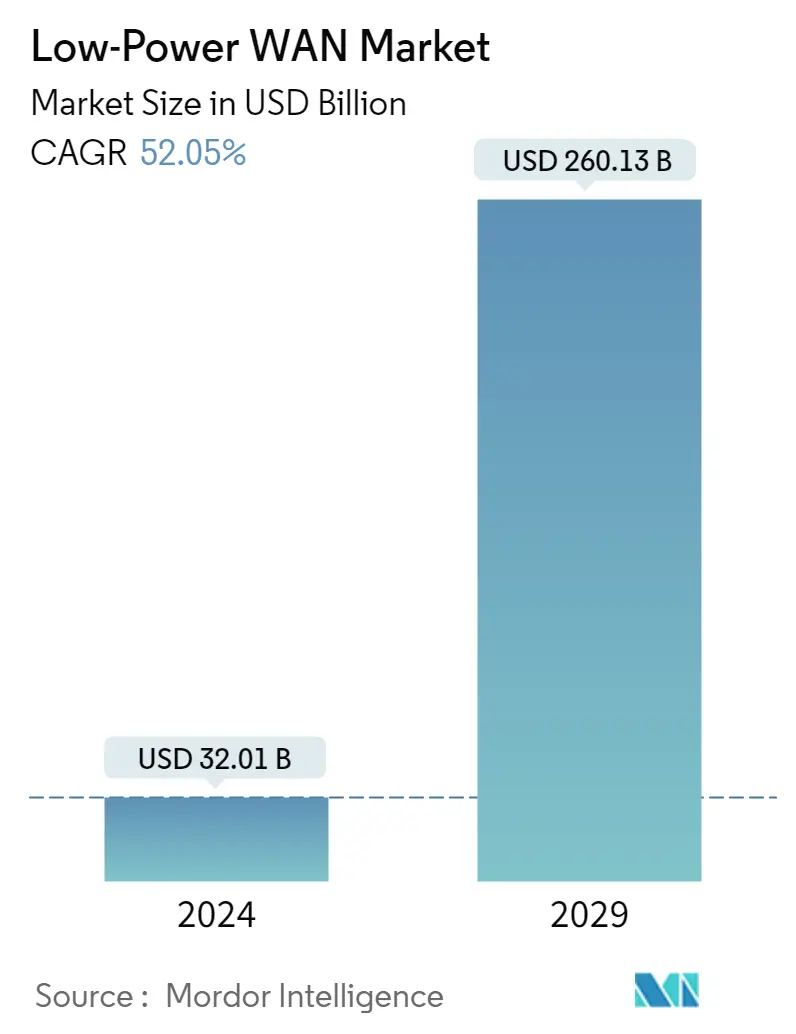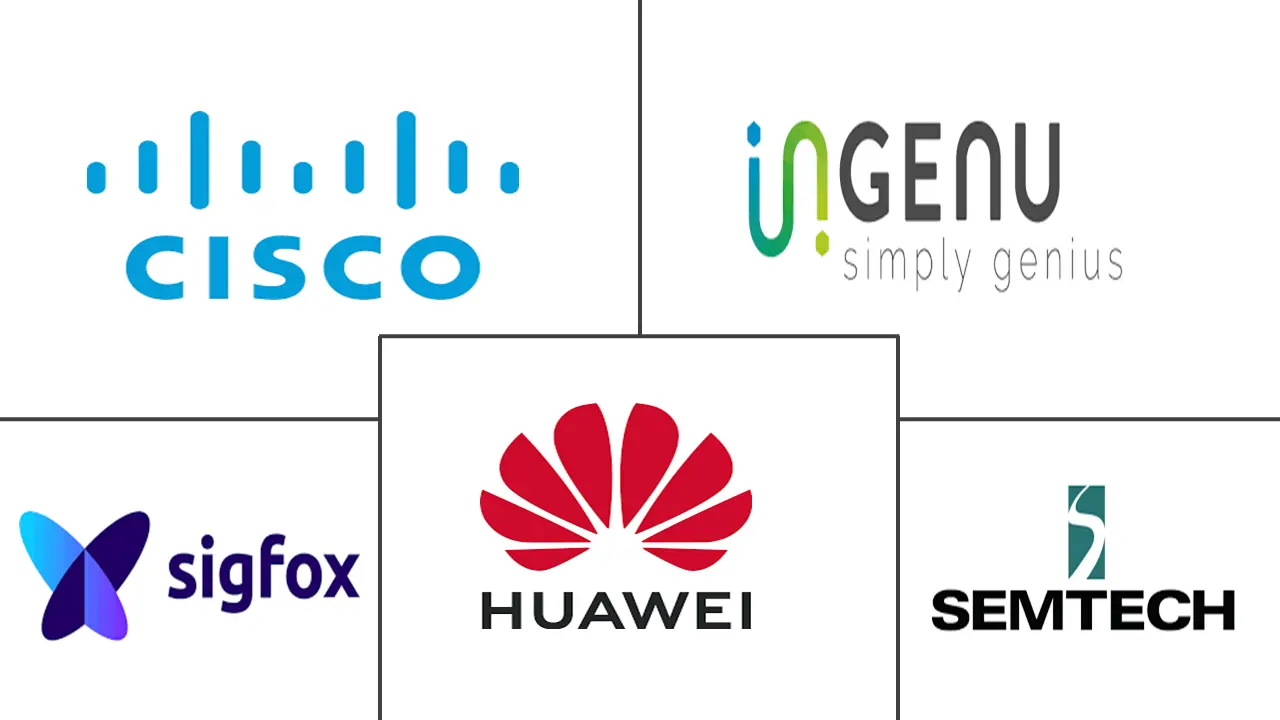Market Size of Low-Power WAN Industry

| Study Period | 2019 - 2029 |
| Market Size (2024) | USD 32.01 Billion |
| Market Size (2029) | USD 260.13 Billion |
| CAGR (2024 - 2029) | 52.05 % |
| Fastest Growing Market | Asia Pacific |
| Largest Market | North America |
Major Players
*Disclaimer: Major Players sorted in no particular order |
Low-Power WAN Market Analysis
The Low-Power WAN Market size is estimated at USD 32.01 billion in 2024, and is expected to reach USD 260.13 billion by 2029, growing at a CAGR of 52.05% during the forecast period (2024-2029).
A low-power WAN (LPWAN) wireless wide area network connects low-bandwidth, battery-operated devices at low bit rates over large distances.
- Over the forecast period, it is predicted that the growing need for low-power wide-area connectivity in the Internet of Things (IoT) applications will propel the growth of the entire market.
- Applying the abovementioned capabilities increases productivity twofold and aids in tracking crop development. In this industry, LPWAN facilitates the transmission of small amounts of data across long distances, which is anticipated to positively affect market growth throughout the forecast period.
- Fleet management, GPS tracking, smart meters, smart grid management, home automation, waste management, process monitoring and control, and temperature monitoring are just a few of the critical applications of LPWAN.
- Future coverage and scalability, technological coexistence, and real-time communication are only a few of the issues with this technology that could hinder its widespread adoption and commercialization. In addition, network security, which is less reliable than transmitting data back to endpoints, might also be vulnerable to interference.
- The most helpful technology for assisting medical diagnosis and treatment during COVID-19 was 5G, and the trend is still going strong today. Since the network's high capacity and low latency allow the transmission of high-definition footage for processing and analytics, the healthcare sector, for example, has profited the most from deploying 5G. With this tool, healthcare providers can recognize patients acting differently than average, having just undergone an incident like a fall, or becoming a danger to themselves or others.
Low-Power WAN Industry Segmentation
Low-power wide-area network (LPWAN) is a particular network that enables long-range communication at a low bit rate. LPWAN overcomes the technological choice for constructing IoT networks globally. This wireless technology can be integrated into streetlights, cars, manufacturing equipment, home appliances, and wearable devices. LPWAN offers a plausible mix of long-range, low power consumption, and secure data transmission.
The Low Power WAN Market is segmented by Type (NB-IoT, Lorawan, and LTE-M), Service (Professional Service and Managed Service), End-user (Oil and Gas, Consumer Electronics, Healthcare, Industrial Manufacturing, and Logistics and Travelling), Application (Smart Meters, Smart Buildings, Smart logistics, and Smart Agriculture), and Geography (North America, Europe, Asia-Pacific, Middle East & Africa, Latin America). The market sizes and forecasts are provided in terms of value (USD million) for all the above segments.
| By Type | |
| LoRaWAN | |
| NB-IoT | |
| LTE-M | |
| Other Types (Sigfox, Weightless, etc.) |
| By Service | |
| Professional Service | |
| Managed Service |
| By End-user | |
| Oil and Gas | |
| Consumer Electronics | |
| Healthcare | |
| Industrial Manufacturing | |
| Logistics and Travelling | |
| Other End-users |
| By Application | |
| Smart Cities | |
| Smart Homes/Buildings | |
| Smart Agriculture | |
| Other Applications |
| By Geography | |
| North America | |
| Europe | |
| Asia-Pacific | |
| Latin America | |
| Middle East & Africa |
Low-Power WAN Market Size Summary
The low-power WAN market is poised for significant growth, driven by the increasing demand for connectivity in Internet of Things (IoT) applications. This technology enables the connection of low-bandwidth, battery-operated devices over large distances, making it ideal for applications such as fleet management, smart meters, and home automation. The market's expansion is further supported by the rise of smart cities and the Industrial Internet of Things, particularly in regions like North America, where there is a strong focus on digital infrastructure development. Despite challenges such as network security and technological coexistence, the market is expected to thrive as LPWAN offers practical solutions for data transmission over unlicensed spectrum bands.
The market landscape is moderately fragmented, with key players like Cisco Systems Inc., Sigfox SA, and Semtech Corporation actively investing in technological advancements and market expansion. Recent developments include the introduction of new products and partnerships aimed at enhancing IoT solutions and expanding market reach. For instance, Semtech Corporation's LoRa technology and Sigfox's 0G technology are being integrated into various applications to improve connectivity and energy efficiency. These advancements, coupled with government support and consumer interest in future technologies, are expected to drive the adoption and commercialization of LPWAN solutions across different sectors.
Low-Power WAN Market Size - Table of Contents
-
1. MARKET INSIGHTS
-
1.1 Market Overview
-
1.2 Industry Value Chain Analysis
-
1.3 Industry Attractiveness - Porter's Five Forces Analysis
-
1.3.1 Bargaining Power of Buyers/Consumers
-
1.3.2 Bargaining Power of Suppliers
-
1.3.3 Threat of New Entrants
-
1.3.4 Threat of Substitute Products
-
1.3.5 Intensity of Competitive Rivalry
-
-
-
2. MARKET SEGMENTATION
-
2.1 By Type
-
2.1.1 LoRaWAN
-
2.1.2 NB-IoT
-
2.1.3 LTE-M
-
2.1.4 Other Types (Sigfox, Weightless, etc.)
-
-
2.2 By Service
-
2.2.1 Professional Service
-
2.2.2 Managed Service
-
-
2.3 By End-user
-
2.3.1 Oil and Gas
-
2.3.2 Consumer Electronics
-
2.3.3 Healthcare
-
2.3.4 Industrial Manufacturing
-
2.3.5 Logistics and Travelling
-
2.3.6 Other End-users
-
-
2.4 By Application
-
2.4.1 Smart Cities
-
2.4.2 Smart Homes/Buildings
-
2.4.3 Smart Agriculture
-
2.4.4 Other Applications
-
-
2.5 By Geography
-
2.5.1 North America
-
2.5.2 Europe
-
2.5.3 Asia-Pacific
-
2.5.4 Latin America
-
2.5.5 Middle East & Africa
-
-
Low-Power WAN Market Size FAQs
How big is the Low-Power WAN Market?
The Low-Power WAN Market size is expected to reach USD 32.01 billion in 2024 and grow at a CAGR of 52.05% to reach USD 260.13 billion by 2029.
What is the current Low-Power WAN Market size?
In 2024, the Low-Power WAN Market size is expected to reach USD 32.01 billion.

